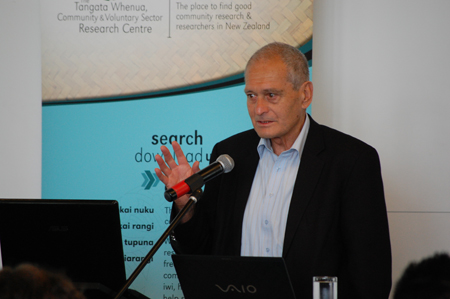He mini mahana ki a kōutou i te wiki nei.
My post last week gave a brief introduction to the Community-Up Approach to Defining Research Conduct. This approach was recently used by Vivienne Kennedy (Ngāti Hine, Ngāti Porou) and me to think through an ethical approach for undertaking research with whānau collectives. Why collectives you may ask (and if you didn’t, I’ll tell you anyway).

In his speech at Te Anga Mua Hui, Professor Sir Mason Durie touched upon the reason; namely, that whānau are so much more than a collection of discreet individuals living under the same roof. First, our connections to whānau extend beyond the walls of our own particular dwelling. Second, collecting data from each individual will only ever provide an approximation of whānau lived realities. In other words, something goes on for whānau that’s about how we interact, engage with, and support one another that requires researchers to think more actively about us as collectives (Cram & Kennedy, 2010). This was the driver of research we undertook in 2009-10 with the support of a Health Research Council Partnership Grant.
We called our adaptation of the Community-Up Approach, Te Kaupapa a te Whānau. The ethical framing of research with whānau we wanted to capture in Te Kaupapa a te Whānau is one in which research with whānau is lead by whānau, with researchers working alongside them in their own place, at their own pace, and to their agenda (see Table 2 below). This approach may require discussions with whānau about research and what each party (whānau and researchers) means by this term and its implementation within a whānau context. Like the more general Community-Up Approach, Te Kaupapa a te Whānau was developed as a possible starting point for these conversations rather than as a recipe book for how researchers should behave.
Table 2. ‘Community-Up’ Approach to Defining Research Conduct with Whānau
|
Cultural Values (Smith, 1999)
|
Te Kaupapa a te Whānau – Whānau researcher guidelines
(Kennedy & Cram, 2010)
|
|
1. Aroha ki te tangata
|
· Engage in cultural ‘rituals of encounter’, guided by whānau
· Allow whānau to define their space and meet on their own terms
· Whakawhanaungatanga – it is important for whānau to make linkages and connections with each other and with the researcher(s)
· Respect the fluidity and diversity of whānau
|
|
2. He kanohi kitea
|
· It is important for the researcher to be known and be seen by whānau
|
|
3. Titiro, whakarongo… kōrero
|
· Allow whānau to set the agenda for the research, including the pace at which it proceeds and decisions about:
· What is the whānau’s story?
· What do whānau want to speak to?
· What is the role of researchers within the space that whānau claim?
|
|
4. Manaaki ki te tangata
|
· Enable whānau to participate in the research (e.g. budget for whānau travel)
· Provide food and refreshments during research encounters
· Allow for appropriate koha for whānau
· Enable whānau to move in and out of their [research] space
|
|
5. Kia tupato
|
· Be cautious that our whānau are kept safe –that whānau are left in the same, or a better, space than before they engaged in the research
· Allow whānau the time and space to practice their own tikanga (e.g. karakia)
· It may be important for the whānau to know of support services that can offer them ongoing support for any issues and concerns raised during the research
|
|
6. Kaua e takahia te mana o te tangata
|
· Ensure that the research journey is enjoyable and enlightening for whānau, including:
· Communicate with whānau about the research, including sharing the findings and publications
· Acknowledge whānau ideas about the current and future research
|
|
7. Kia mahaki
|
· Be humble – do not flaunt your knowledge, but find ways to create a context for whānau to access it
· Answer whānau questions (or seek out the knowledge) and share your knowledge
· Support whānau in their understanding and use of research findings
|
Source. Adapted from Smith (2006, p.12, Diagram 1)
As part of the HRC research project a number of researchers wrote about the methods they thought would be useful additions to the researcher’s kete (toolkit) when they undertake research with whānau. These methods are showcased in the December 2010 issue of the MAI Review, and include Genograms, PATH, Appreciative Inquiry and Participatory Action Research. The researchers writing about these methods describe why they think the method is appropriate for research with whānau. This is done in such a way to invite discussion and debate about methods and whether or not we can use them within whānau research.
There is much more discussion to be had and a definite joy of Whānau Ora, from this researcher’s perspective, is that now such discussions are seen as more valid within wider circles as we move to a place where we desire to understand exactly what the potential of Whānau Ora is as a catalyst for whānau change. In order to understand this we need to use research methods that capture and seek to understand the complexities and inter-relationships that are whānau, whānau joys and their frustrations, and the support and leadership whānau find in one another. Unsurprisingly perhaps, we are seeking to understand the very nature of whanaungatanga and when and how it is strengthened.
Submitted by Fiona Cram
References
Cram, F. & Kennedy, V. (2010). Researching with whānau collectives. MAI Review, December, Issue 3, Article 1.
Kennedy, V. & Cram, F. (2010). Ethics of researching with whānau collectives. MAI Review,December, Issue 3, Article 2.
